Leadership and Management Styles and Culture at Al Mouj Muscat
VerifiedAdded on 2023/03/31
|14
|2987
|84
Report
AI Summary
This report provides a critical evaluation of leadership and management styles, focusing on Al Mouj Muscat, a property management company. It explores the application of the Seven Leadership Mindsets Theory (vMEME) to assess leadership effectiveness, organizational culture, and its impact on employee performance and productivity. The report examines democratic and participative leadership approaches, and analyzes the determination of strategic direction within the organization. Furthermore, it delves into personal leadership capabilities, assessing the project manager's skills and identifying areas for development based on the vMEME framework. The report concludes with a reflective statement, highlighting the practical application of leadership theories within a real-world context.
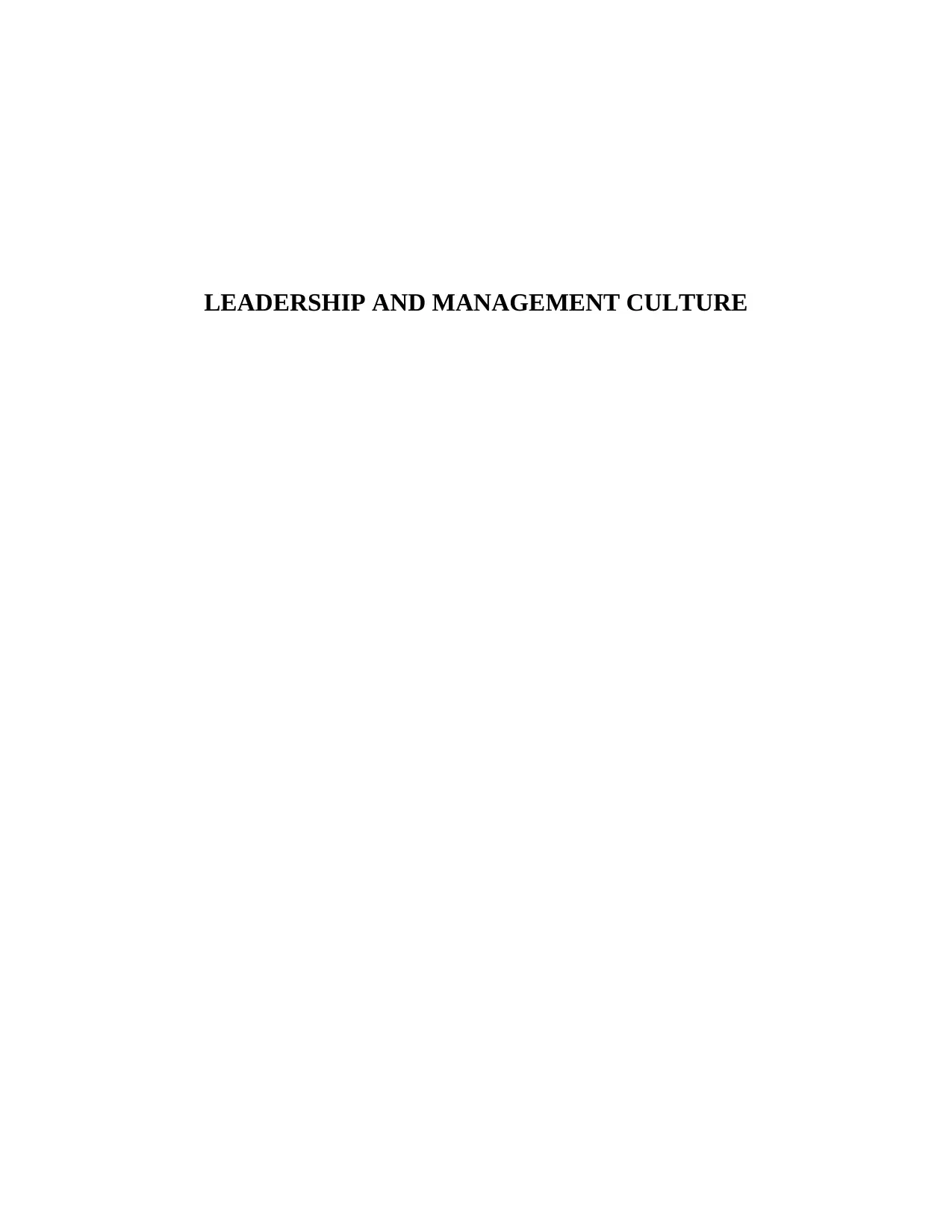
LEADERSHIP AND MANAGEMENT CULTURE
Paraphrase This Document
Need a fresh take? Get an instant paraphrase of this document with our AI Paraphraser
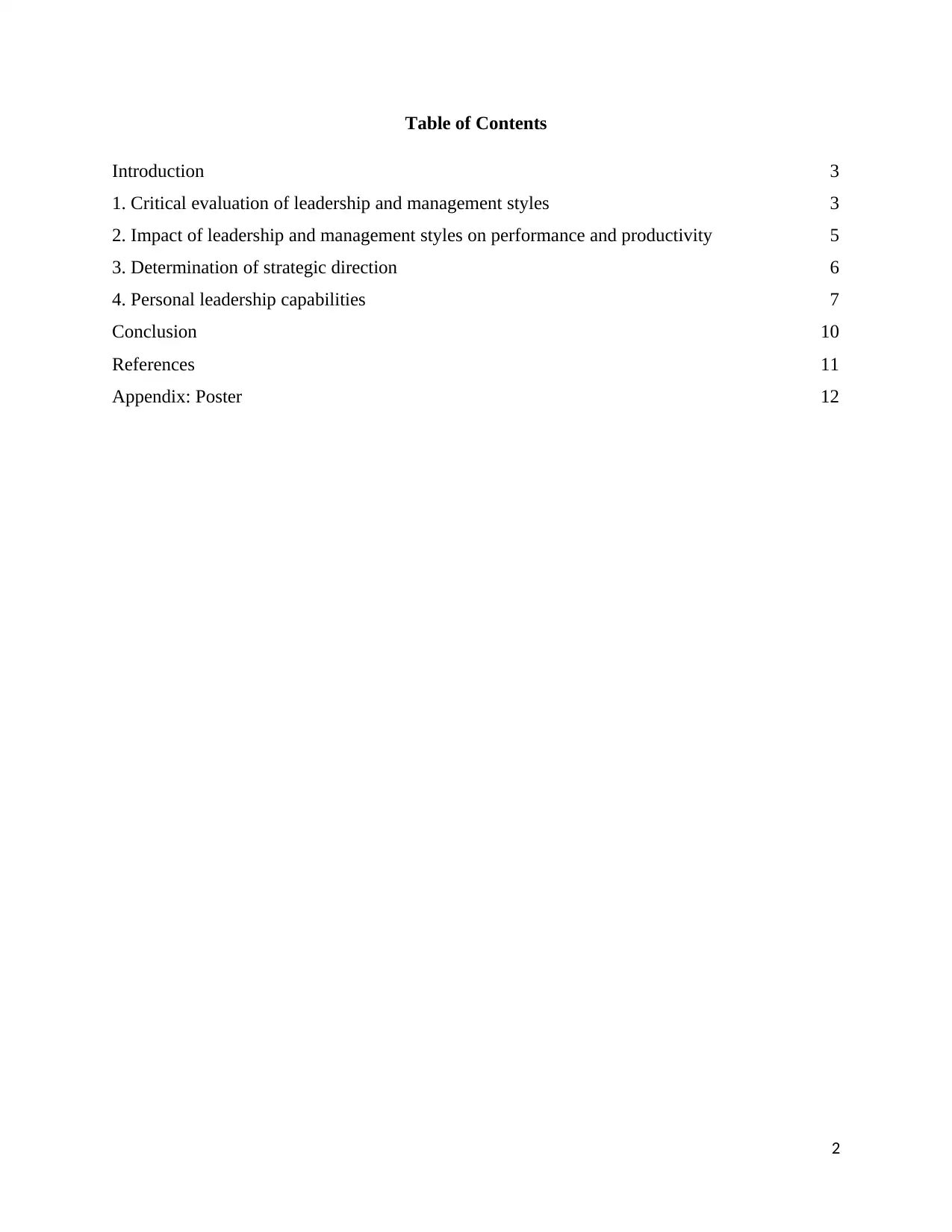
Table of Contents
Introduction 3
1. Critical evaluation of leadership and management styles 3
2. Impact of leadership and management styles on performance and productivity 5
3. Determination of strategic direction 6
4. Personal leadership capabilities 7
Conclusion 10
References 11
Appendix: Poster 12
2
Introduction 3
1. Critical evaluation of leadership and management styles 3
2. Impact of leadership and management styles on performance and productivity 5
3. Determination of strategic direction 6
4. Personal leadership capabilities 7
Conclusion 10
References 11
Appendix: Poster 12
2
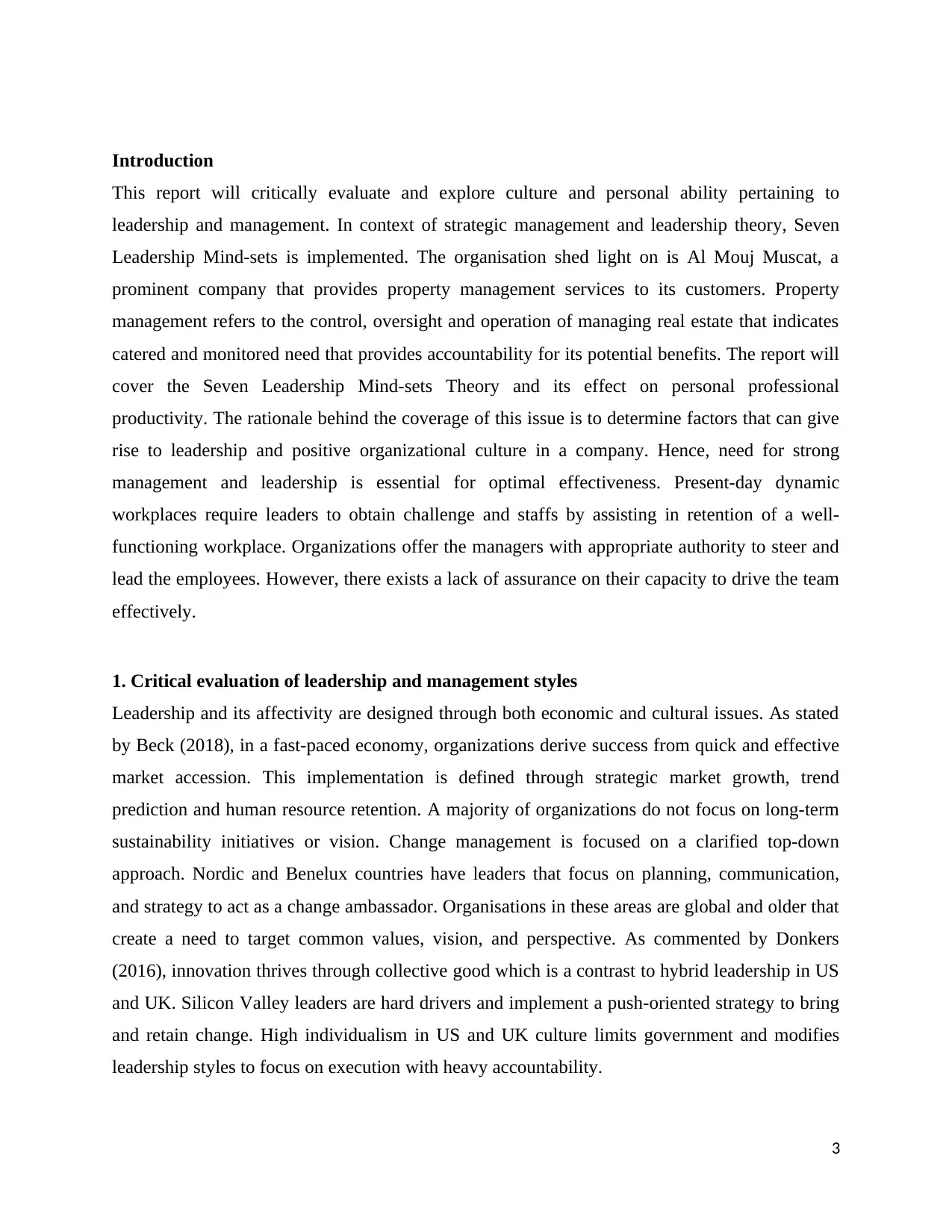
Introduction
This report will critically evaluate and explore culture and personal ability pertaining to
leadership and management. In context of strategic management and leadership theory, Seven
Leadership Mind-sets is implemented. The organisation shed light on is Al Mouj Muscat, a
prominent company that provides property management services to its customers. Property
management refers to the control, oversight and operation of managing real estate that indicates
catered and monitored need that provides accountability for its potential benefits. The report will
cover the Seven Leadership Mind-sets Theory and its effect on personal professional
productivity. The rationale behind the coverage of this issue is to determine factors that can give
rise to leadership and positive organizational culture in a company. Hence, need for strong
management and leadership is essential for optimal effectiveness. Present-day dynamic
workplaces require leaders to obtain challenge and staffs by assisting in retention of a well-
functioning workplace. Organizations offer the managers with appropriate authority to steer and
lead the employees. However, there exists a lack of assurance on their capacity to drive the team
effectively.
1. Critical evaluation of leadership and management styles
Leadership and its affectivity are designed through both economic and cultural issues. As stated
by Beck (2018), in a fast-paced economy, organizations derive success from quick and effective
market accession. This implementation is defined through strategic market growth, trend
prediction and human resource retention. A majority of organizations do not focus on long-term
sustainability initiatives or vision. Change management is focused on a clarified top-down
approach. Nordic and Benelux countries have leaders that focus on planning, communication,
and strategy to act as a change ambassador. Organisations in these areas are global and older that
create a need to target common values, vision, and perspective. As commented by Donkers
(2016), innovation thrives through collective good which is a contrast to hybrid leadership in US
and UK. Silicon Valley leaders are hard drivers and implement a push-oriented strategy to bring
and retain change. High individualism in US and UK culture limits government and modifies
leadership styles to focus on execution with heavy accountability.
3
This report will critically evaluate and explore culture and personal ability pertaining to
leadership and management. In context of strategic management and leadership theory, Seven
Leadership Mind-sets is implemented. The organisation shed light on is Al Mouj Muscat, a
prominent company that provides property management services to its customers. Property
management refers to the control, oversight and operation of managing real estate that indicates
catered and monitored need that provides accountability for its potential benefits. The report will
cover the Seven Leadership Mind-sets Theory and its effect on personal professional
productivity. The rationale behind the coverage of this issue is to determine factors that can give
rise to leadership and positive organizational culture in a company. Hence, need for strong
management and leadership is essential for optimal effectiveness. Present-day dynamic
workplaces require leaders to obtain challenge and staffs by assisting in retention of a well-
functioning workplace. Organizations offer the managers with appropriate authority to steer and
lead the employees. However, there exists a lack of assurance on their capacity to drive the team
effectively.
1. Critical evaluation of leadership and management styles
Leadership and its affectivity are designed through both economic and cultural issues. As stated
by Beck (2018), in a fast-paced economy, organizations derive success from quick and effective
market accession. This implementation is defined through strategic market growth, trend
prediction and human resource retention. A majority of organizations do not focus on long-term
sustainability initiatives or vision. Change management is focused on a clarified top-down
approach. Nordic and Benelux countries have leaders that focus on planning, communication,
and strategy to act as a change ambassador. Organisations in these areas are global and older that
create a need to target common values, vision, and perspective. As commented by Donkers
(2016), innovation thrives through collective good which is a contrast to hybrid leadership in US
and UK. Silicon Valley leaders are hard drivers and implement a push-oriented strategy to bring
and retain change. High individualism in US and UK culture limits government and modifies
leadership styles to focus on execution with heavy accountability.
3
⊘ This is a preview!⊘
Do you want full access?
Subscribe today to unlock all pages.

Trusted by 1+ million students worldwide
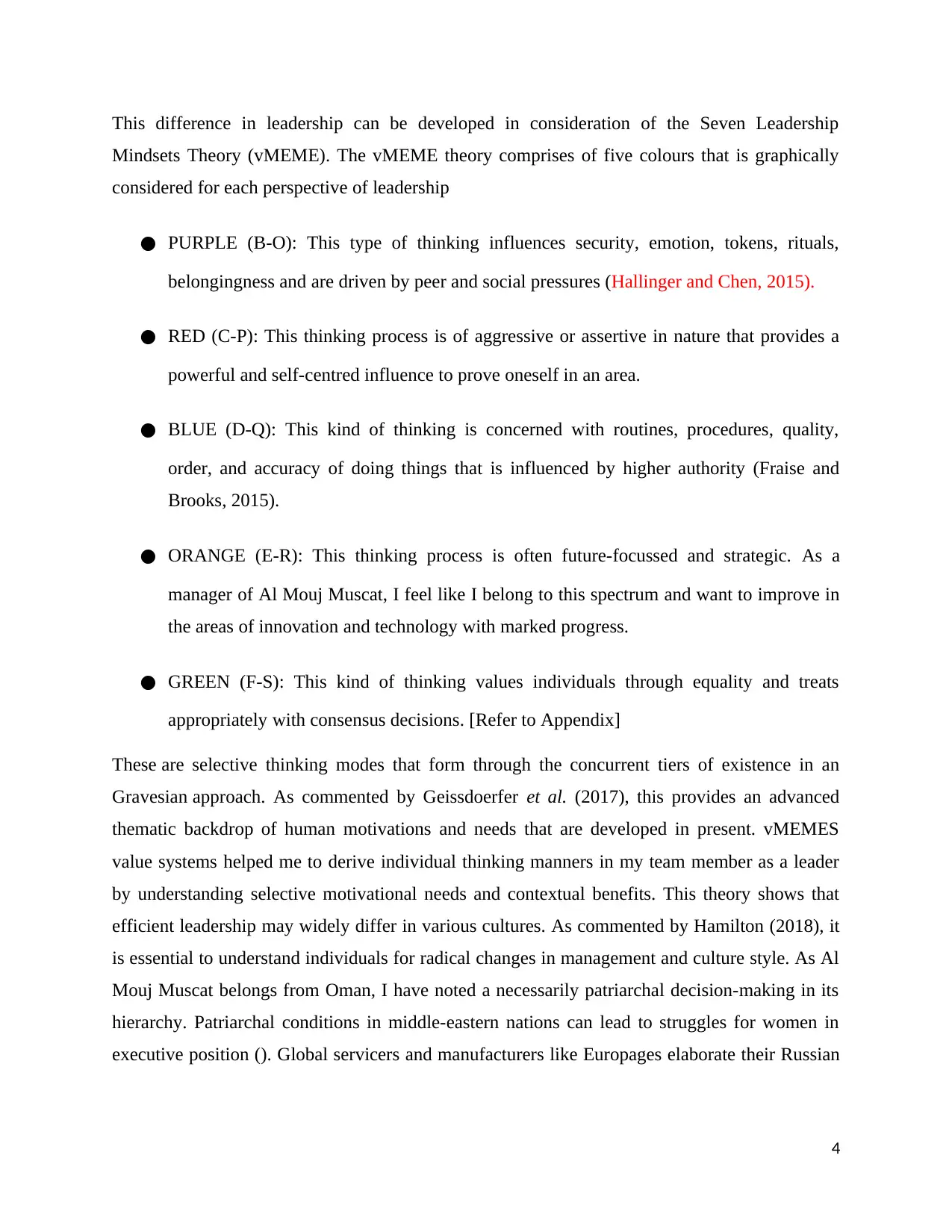
This difference in leadership can be developed in consideration of the Seven Leadership
Mindsets Theory (vMEME). The vMEME theory comprises of five colours that is graphically
considered for each perspective of leadership
● PURPLE (B-O): This type of thinking influences security, emotion, tokens, rituals,
belongingness and are driven by peer and social pressures (Hallinger and Chen, 2015).
● RED (C-P): This thinking process is of aggressive or assertive in nature that provides a
powerful and self-centred influence to prove oneself in an area.
● BLUE (D-Q): This kind of thinking is concerned with routines, procedures, quality,
order, and accuracy of doing things that is influenced by higher authority (Fraise and
Brooks, 2015).
● ORANGE (E-R): This thinking process is often future-focussed and strategic. As a
manager of Al Mouj Muscat, I feel like I belong to this spectrum and want to improve in
the areas of innovation and technology with marked progress.
● GREEN (F-S): This kind of thinking values individuals through equality and treats
appropriately with consensus decisions. [Refer to Appendix]
These are selective thinking modes that form through the concurrent tiers of existence in an
Gravesian approach. As commented by Geissdoerfer et al. (2017), this provides an advanced
thematic backdrop of human motivations and needs that are developed in present. vMEMES
value systems helped me to derive individual thinking manners in my team member as a leader
by understanding selective motivational needs and contextual benefits. This theory shows that
efficient leadership may widely differ in various cultures. As commented by Hamilton (2018), it
is essential to understand individuals for radical changes in management and culture style. As Al
Mouj Muscat belongs from Oman, I have noted a necessarily patriarchal decision-making in its
hierarchy. Patriarchal conditions in middle-eastern nations can lead to struggles for women in
executive position (). Global servicers and manufacturers like Europages elaborate their Russian
4
Mindsets Theory (vMEME). The vMEME theory comprises of five colours that is graphically
considered for each perspective of leadership
● PURPLE (B-O): This type of thinking influences security, emotion, tokens, rituals,
belongingness and are driven by peer and social pressures (Hallinger and Chen, 2015).
● RED (C-P): This thinking process is of aggressive or assertive in nature that provides a
powerful and self-centred influence to prove oneself in an area.
● BLUE (D-Q): This kind of thinking is concerned with routines, procedures, quality,
order, and accuracy of doing things that is influenced by higher authority (Fraise and
Brooks, 2015).
● ORANGE (E-R): This thinking process is often future-focussed and strategic. As a
manager of Al Mouj Muscat, I feel like I belong to this spectrum and want to improve in
the areas of innovation and technology with marked progress.
● GREEN (F-S): This kind of thinking values individuals through equality and treats
appropriately with consensus decisions. [Refer to Appendix]
These are selective thinking modes that form through the concurrent tiers of existence in an
Gravesian approach. As commented by Geissdoerfer et al. (2017), this provides an advanced
thematic backdrop of human motivations and needs that are developed in present. vMEMES
value systems helped me to derive individual thinking manners in my team member as a leader
by understanding selective motivational needs and contextual benefits. This theory shows that
efficient leadership may widely differ in various cultures. As commented by Hamilton (2018), it
is essential to understand individuals for radical changes in management and culture style. As Al
Mouj Muscat belongs from Oman, I have noted a necessarily patriarchal decision-making in its
hierarchy. Patriarchal conditions in middle-eastern nations can lead to struggles for women in
executive position (). Global servicers and manufacturers like Europages elaborate their Russian
4
Paraphrase This Document
Need a fresh take? Get an instant paraphrase of this document with our AI Paraphraser
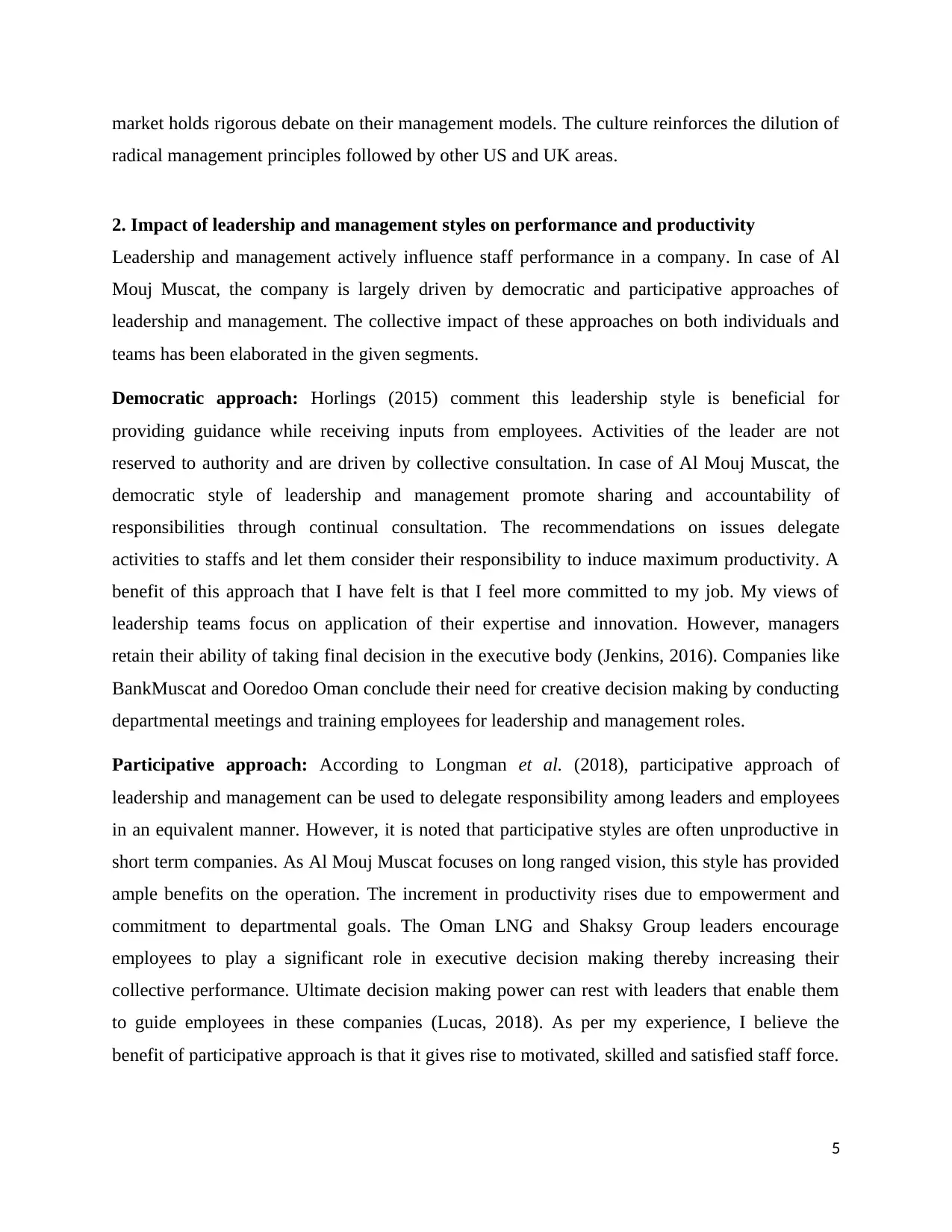
market holds rigorous debate on their management models. The culture reinforces the dilution of
radical management principles followed by other US and UK areas.
2. Impact of leadership and management styles on performance and productivity
Leadership and management actively influence staff performance in a company. In case of Al
Mouj Muscat, the company is largely driven by democratic and participative approaches of
leadership and management. The collective impact of these approaches on both individuals and
teams has been elaborated in the given segments.
Democratic approach: Horlings (2015) comment this leadership style is beneficial for
providing guidance while receiving inputs from employees. Activities of the leader are not
reserved to authority and are driven by collective consultation. In case of Al Mouj Muscat, the
democratic style of leadership and management promote sharing and accountability of
responsibilities through continual consultation. The recommendations on issues delegate
activities to staffs and let them consider their responsibility to induce maximum productivity. A
benefit of this approach that I have felt is that I feel more committed to my job. My views of
leadership teams focus on application of their expertise and innovation. However, managers
retain their ability of taking final decision in the executive body (Jenkins, 2016). Companies like
BankMuscat and Ooredoo Oman conclude their need for creative decision making by conducting
departmental meetings and training employees for leadership and management roles.
Participative approach: According to Longman et al. (2018), participative approach of
leadership and management can be used to delegate responsibility among leaders and employees
in an equivalent manner. However, it is noted that participative styles are often unproductive in
short term companies. As Al Mouj Muscat focuses on long ranged vision, this style has provided
ample benefits on the operation. The increment in productivity rises due to empowerment and
commitment to departmental goals. The Oman LNG and Shaksy Group leaders encourage
employees to play a significant role in executive decision making thereby increasing their
collective performance. Ultimate decision making power can rest with leaders that enable them
to guide employees in these companies (Lucas, 2018). As per my experience, I believe the
benefit of participative approach is that it gives rise to motivated, skilled and satisfied staff force.
5
radical management principles followed by other US and UK areas.
2. Impact of leadership and management styles on performance and productivity
Leadership and management actively influence staff performance in a company. In case of Al
Mouj Muscat, the company is largely driven by democratic and participative approaches of
leadership and management. The collective impact of these approaches on both individuals and
teams has been elaborated in the given segments.
Democratic approach: Horlings (2015) comment this leadership style is beneficial for
providing guidance while receiving inputs from employees. Activities of the leader are not
reserved to authority and are driven by collective consultation. In case of Al Mouj Muscat, the
democratic style of leadership and management promote sharing and accountability of
responsibilities through continual consultation. The recommendations on issues delegate
activities to staffs and let them consider their responsibility to induce maximum productivity. A
benefit of this approach that I have felt is that I feel more committed to my job. My views of
leadership teams focus on application of their expertise and innovation. However, managers
retain their ability of taking final decision in the executive body (Jenkins, 2016). Companies like
BankMuscat and Ooredoo Oman conclude their need for creative decision making by conducting
departmental meetings and training employees for leadership and management roles.
Participative approach: According to Longman et al. (2018), participative approach of
leadership and management can be used to delegate responsibility among leaders and employees
in an equivalent manner. However, it is noted that participative styles are often unproductive in
short term companies. As Al Mouj Muscat focuses on long ranged vision, this style has provided
ample benefits on the operation. The increment in productivity rises due to empowerment and
commitment to departmental goals. The Oman LNG and Shaksy Group leaders encourage
employees to play a significant role in executive decision making thereby increasing their
collective performance. Ultimate decision making power can rest with leaders that enable them
to guide employees in these companies (Lucas, 2018). As per my experience, I believe the
benefit of participative approach is that it gives rise to motivated, skilled and satisfied staff force.
5
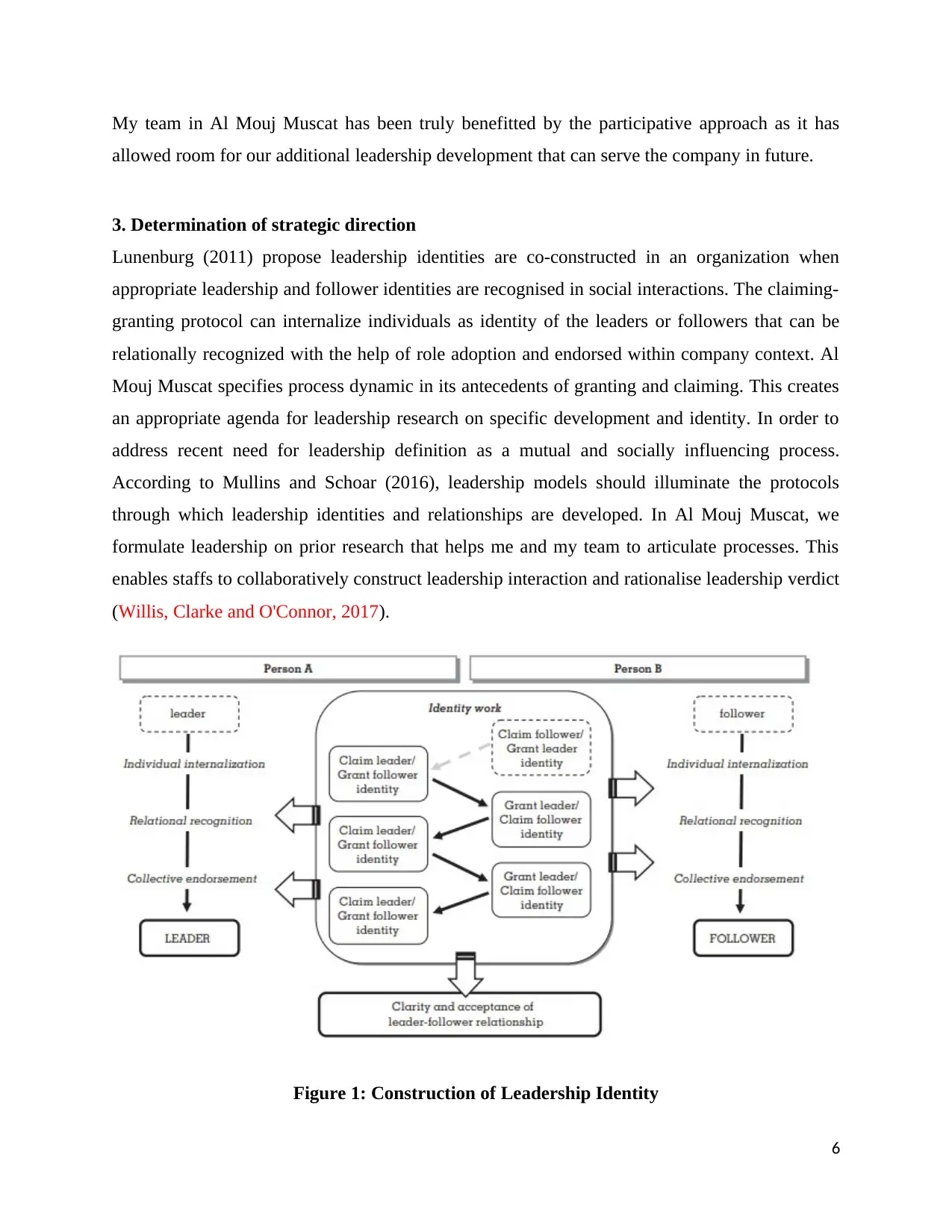
My team in Al Mouj Muscat has been truly benefitted by the participative approach as it has
allowed room for our additional leadership development that can serve the company in future.
3. Determination of strategic direction
Lunenburg (2011) propose leadership identities are co-constructed in an organization when
appropriate leadership and follower identities are recognised in social interactions. The claiming-
granting protocol can internalize individuals as identity of the leaders or followers that can be
relationally recognized with the help of role adoption and endorsed within company context. Al
Mouj Muscat specifies process dynamic in its antecedents of granting and claiming. This creates
an appropriate agenda for leadership research on specific development and identity. In order to
address recent need for leadership definition as a mutual and socially influencing process.
According to Mullins and Schoar (2016), leadership models should illuminate the protocols
through which leadership identities and relationships are developed. In Al Mouj Muscat, we
formulate leadership on prior research that helps me and my team to articulate processes. This
enables staffs to collaboratively construct leadership interaction and rationalise leadership verdict
(Willis, Clarke and O'Connor, 2017).
Figure 1: Construction of Leadership Identity
6
allowed room for our additional leadership development that can serve the company in future.
3. Determination of strategic direction
Lunenburg (2011) propose leadership identities are co-constructed in an organization when
appropriate leadership and follower identities are recognised in social interactions. The claiming-
granting protocol can internalize individuals as identity of the leaders or followers that can be
relationally recognized with the help of role adoption and endorsed within company context. Al
Mouj Muscat specifies process dynamic in its antecedents of granting and claiming. This creates
an appropriate agenda for leadership research on specific development and identity. In order to
address recent need for leadership definition as a mutual and socially influencing process.
According to Mullins and Schoar (2016), leadership models should illuminate the protocols
through which leadership identities and relationships are developed. In Al Mouj Muscat, we
formulate leadership on prior research that helps me and my team to articulate processes. This
enables staffs to collaboratively construct leadership interaction and rationalise leadership verdict
(Willis, Clarke and O'Connor, 2017).
Figure 1: Construction of Leadership Identity
6
⊘ This is a preview!⊘
Do you want full access?
Subscribe today to unlock all pages.

Trusted by 1+ million students worldwide
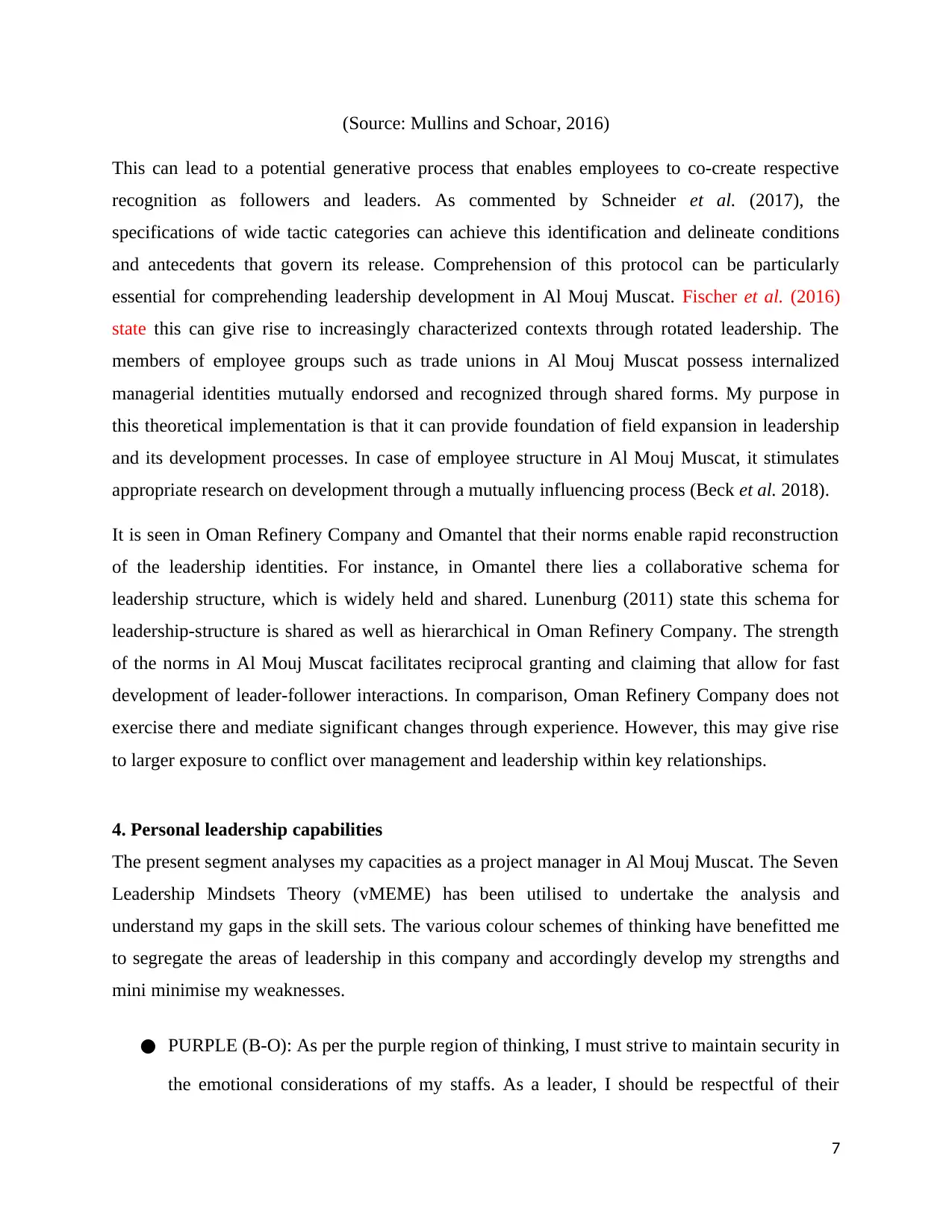
(Source: Mullins and Schoar, 2016)
This can lead to a potential generative process that enables employees to co-create respective
recognition as followers and leaders. As commented by Schneider et al. (2017), the
specifications of wide tactic categories can achieve this identification and delineate conditions
and antecedents that govern its release. Comprehension of this protocol can be particularly
essential for comprehending leadership development in Al Mouj Muscat. Fischer et al. (2016)
state this can give rise to increasingly characterized contexts through rotated leadership. The
members of employee groups such as trade unions in Al Mouj Muscat possess internalized
managerial identities mutually endorsed and recognized through shared forms. My purpose in
this theoretical implementation is that it can provide foundation of field expansion in leadership
and its development processes. In case of employee structure in Al Mouj Muscat, it stimulates
appropriate research on development through a mutually influencing process (Beck et al. 2018).
It is seen in Oman Refinery Company and Omantel that their norms enable rapid reconstruction
of the leadership identities. For instance, in Omantel there lies a collaborative schema for
leadership structure, which is widely held and shared. Lunenburg (2011) state this schema for
leadership-structure is shared as well as hierarchical in Oman Refinery Company. The strength
of the norms in Al Mouj Muscat facilitates reciprocal granting and claiming that allow for fast
development of leader-follower interactions. In comparison, Oman Refinery Company does not
exercise there and mediate significant changes through experience. However, this may give rise
to larger exposure to conflict over management and leadership within key relationships.
4. Personal leadership capabilities
The present segment analyses my capacities as a project manager in Al Mouj Muscat. The Seven
Leadership Mindsets Theory (vMEME) has been utilised to undertake the analysis and
understand my gaps in the skill sets. The various colour schemes of thinking have benefitted me
to segregate the areas of leadership in this company and accordingly develop my strengths and
mini minimise my weaknesses.
● PURPLE (B-O): As per the purple region of thinking, I must strive to maintain security in
the emotional considerations of my staffs. As a leader, I should be respectful of their
7
This can lead to a potential generative process that enables employees to co-create respective
recognition as followers and leaders. As commented by Schneider et al. (2017), the
specifications of wide tactic categories can achieve this identification and delineate conditions
and antecedents that govern its release. Comprehension of this protocol can be particularly
essential for comprehending leadership development in Al Mouj Muscat. Fischer et al. (2016)
state this can give rise to increasingly characterized contexts through rotated leadership. The
members of employee groups such as trade unions in Al Mouj Muscat possess internalized
managerial identities mutually endorsed and recognized through shared forms. My purpose in
this theoretical implementation is that it can provide foundation of field expansion in leadership
and its development processes. In case of employee structure in Al Mouj Muscat, it stimulates
appropriate research on development through a mutually influencing process (Beck et al. 2018).
It is seen in Oman Refinery Company and Omantel that their norms enable rapid reconstruction
of the leadership identities. For instance, in Omantel there lies a collaborative schema for
leadership structure, which is widely held and shared. Lunenburg (2011) state this schema for
leadership-structure is shared as well as hierarchical in Oman Refinery Company. The strength
of the norms in Al Mouj Muscat facilitates reciprocal granting and claiming that allow for fast
development of leader-follower interactions. In comparison, Oman Refinery Company does not
exercise there and mediate significant changes through experience. However, this may give rise
to larger exposure to conflict over management and leadership within key relationships.
4. Personal leadership capabilities
The present segment analyses my capacities as a project manager in Al Mouj Muscat. The Seven
Leadership Mindsets Theory (vMEME) has been utilised to undertake the analysis and
understand my gaps in the skill sets. The various colour schemes of thinking have benefitted me
to segregate the areas of leadership in this company and accordingly develop my strengths and
mini minimise my weaknesses.
● PURPLE (B-O): As per the purple region of thinking, I must strive to maintain security in
the emotional considerations of my staffs. As a leader, I should be respectful of their
7
Paraphrase This Document
Need a fresh take? Get an instant paraphrase of this document with our AI Paraphraser
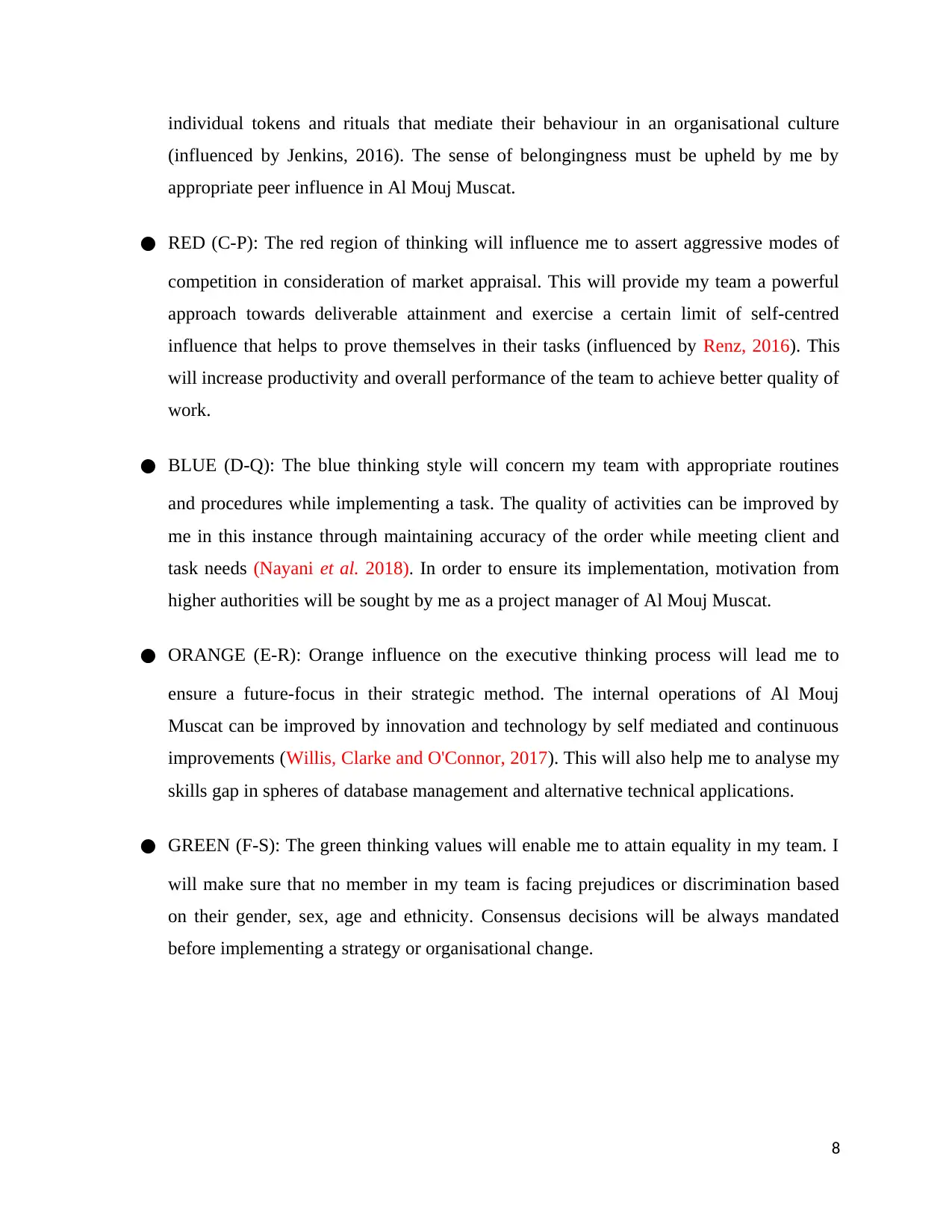
individual tokens and rituals that mediate their behaviour in an organisational culture
(influenced by Jenkins, 2016). The sense of belongingness must be upheld by me by
appropriate peer influence in Al Mouj Muscat.
● RED (C-P): The red region of thinking will influence me to assert aggressive modes of
competition in consideration of market appraisal. This will provide my team a powerful
approach towards deliverable attainment and exercise a certain limit of self-centred
influence that helps to prove themselves in their tasks (influenced by Renz, 2016). This
will increase productivity and overall performance of the team to achieve better quality of
work.
● BLUE (D-Q): The blue thinking style will concern my team with appropriate routines
and procedures while implementing a task. The quality of activities can be improved by
me in this instance through maintaining accuracy of the order while meeting client and
task needs (Nayani et al. 2018). In order to ensure its implementation, motivation from
higher authorities will be sought by me as a project manager of Al Mouj Muscat.
● ORANGE (E-R): Orange influence on the executive thinking process will lead me to
ensure a future-focus in their strategic method. The internal operations of Al Mouj
Muscat can be improved by innovation and technology by self mediated and continuous
improvements (Willis, Clarke and O'Connor, 2017). This will also help me to analyse my
skills gap in spheres of database management and alternative technical applications.
● GREEN (F-S): The green thinking values will enable me to attain equality in my team. I
will make sure that no member in my team is facing prejudices or discrimination based
on their gender, sex, age and ethnicity. Consensus decisions will be always mandated
before implementing a strategy or organisational change.
8
(influenced by Jenkins, 2016). The sense of belongingness must be upheld by me by
appropriate peer influence in Al Mouj Muscat.
● RED (C-P): The red region of thinking will influence me to assert aggressive modes of
competition in consideration of market appraisal. This will provide my team a powerful
approach towards deliverable attainment and exercise a certain limit of self-centred
influence that helps to prove themselves in their tasks (influenced by Renz, 2016). This
will increase productivity and overall performance of the team to achieve better quality of
work.
● BLUE (D-Q): The blue thinking style will concern my team with appropriate routines
and procedures while implementing a task. The quality of activities can be improved by
me in this instance through maintaining accuracy of the order while meeting client and
task needs (Nayani et al. 2018). In order to ensure its implementation, motivation from
higher authorities will be sought by me as a project manager of Al Mouj Muscat.
● ORANGE (E-R): Orange influence on the executive thinking process will lead me to
ensure a future-focus in their strategic method. The internal operations of Al Mouj
Muscat can be improved by innovation and technology by self mediated and continuous
improvements (Willis, Clarke and O'Connor, 2017). This will also help me to analyse my
skills gap in spheres of database management and alternative technical applications.
● GREEN (F-S): The green thinking values will enable me to attain equality in my team. I
will make sure that no member in my team is facing prejudices or discrimination based
on their gender, sex, age and ethnicity. Consensus decisions will be always mandated
before implementing a strategy or organisational change.
8
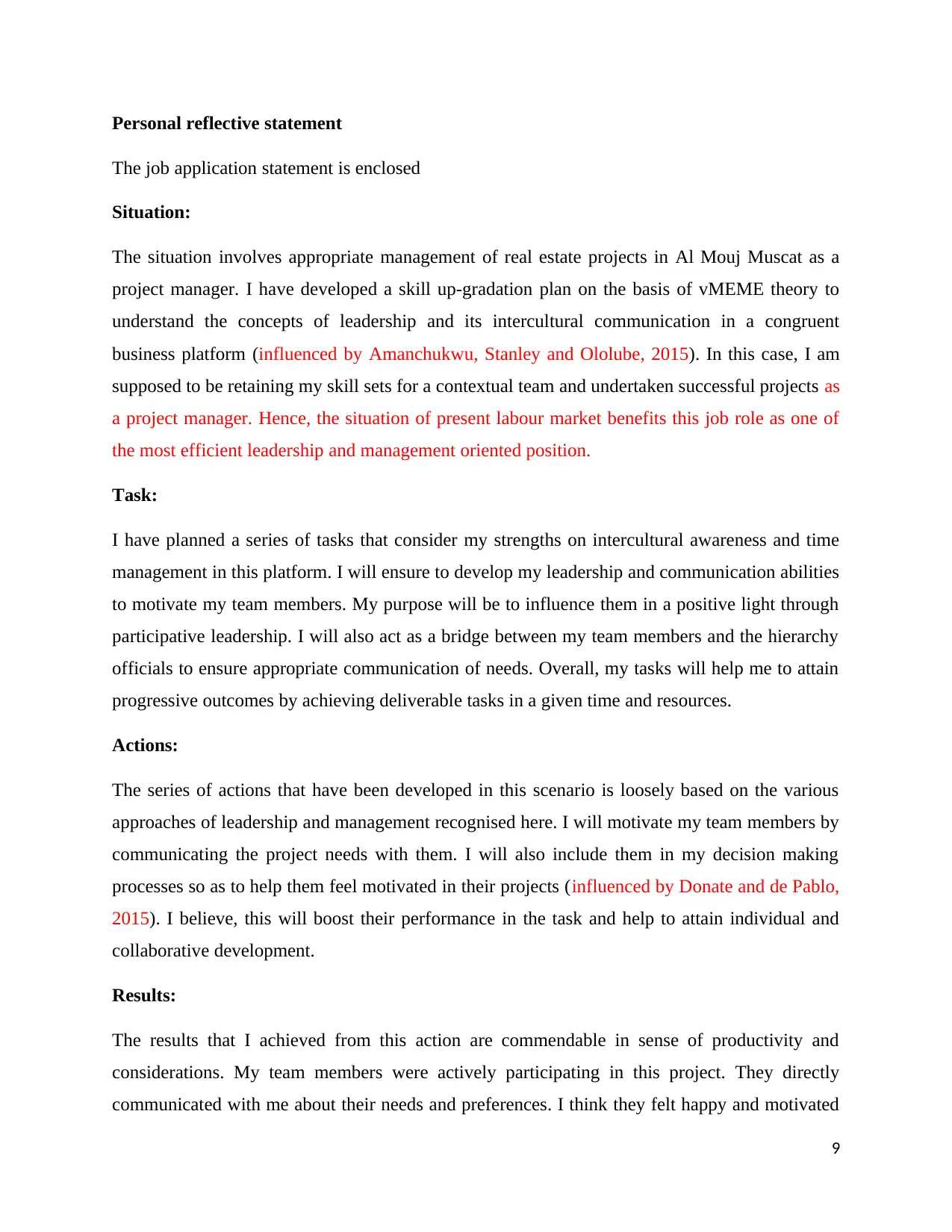
Personal reflective statement
The job application statement is enclosed
Situation:
The situation involves appropriate management of real estate projects in Al Mouj Muscat as a
project manager. I have developed a skill up-gradation plan on the basis of vMEME theory to
understand the concepts of leadership and its intercultural communication in a congruent
business platform (influenced by Amanchukwu, Stanley and Ololube, 2015). In this case, I am
supposed to be retaining my skill sets for a contextual team and undertaken successful projects as
a project manager. Hence, the situation of present labour market benefits this job role as one of
the most efficient leadership and management oriented position.
Task:
I have planned a series of tasks that consider my strengths on intercultural awareness and time
management in this platform. I will ensure to develop my leadership and communication abilities
to motivate my team members. My purpose will be to influence them in a positive light through
participative leadership. I will also act as a bridge between my team members and the hierarchy
officials to ensure appropriate communication of needs. Overall, my tasks will help me to attain
progressive outcomes by achieving deliverable tasks in a given time and resources.
Actions:
The series of actions that have been developed in this scenario is loosely based on the various
approaches of leadership and management recognised here. I will motivate my team members by
communicating the project needs with them. I will also include them in my decision making
processes so as to help them feel motivated in their projects (influenced by Donate and de Pablo,
2015). I believe, this will boost their performance in the task and help to attain individual and
collaborative development.
Results:
The results that I achieved from this action are commendable in sense of productivity and
considerations. My team members were actively participating in this project. They directly
communicated with me about their needs and preferences. I think they felt happy and motivated
9
The job application statement is enclosed
Situation:
The situation involves appropriate management of real estate projects in Al Mouj Muscat as a
project manager. I have developed a skill up-gradation plan on the basis of vMEME theory to
understand the concepts of leadership and its intercultural communication in a congruent
business platform (influenced by Amanchukwu, Stanley and Ololube, 2015). In this case, I am
supposed to be retaining my skill sets for a contextual team and undertaken successful projects as
a project manager. Hence, the situation of present labour market benefits this job role as one of
the most efficient leadership and management oriented position.
Task:
I have planned a series of tasks that consider my strengths on intercultural awareness and time
management in this platform. I will ensure to develop my leadership and communication abilities
to motivate my team members. My purpose will be to influence them in a positive light through
participative leadership. I will also act as a bridge between my team members and the hierarchy
officials to ensure appropriate communication of needs. Overall, my tasks will help me to attain
progressive outcomes by achieving deliverable tasks in a given time and resources.
Actions:
The series of actions that have been developed in this scenario is loosely based on the various
approaches of leadership and management recognised here. I will motivate my team members by
communicating the project needs with them. I will also include them in my decision making
processes so as to help them feel motivated in their projects (influenced by Donate and de Pablo,
2015). I believe, this will boost their performance in the task and help to attain individual and
collaborative development.
Results:
The results that I achieved from this action are commendable in sense of productivity and
considerations. My team members were actively participating in this project. They directly
communicated with me about their needs and preferences. I think they felt happy and motivated
9
⊘ This is a preview!⊘
Do you want full access?
Subscribe today to unlock all pages.

Trusted by 1+ million students worldwide
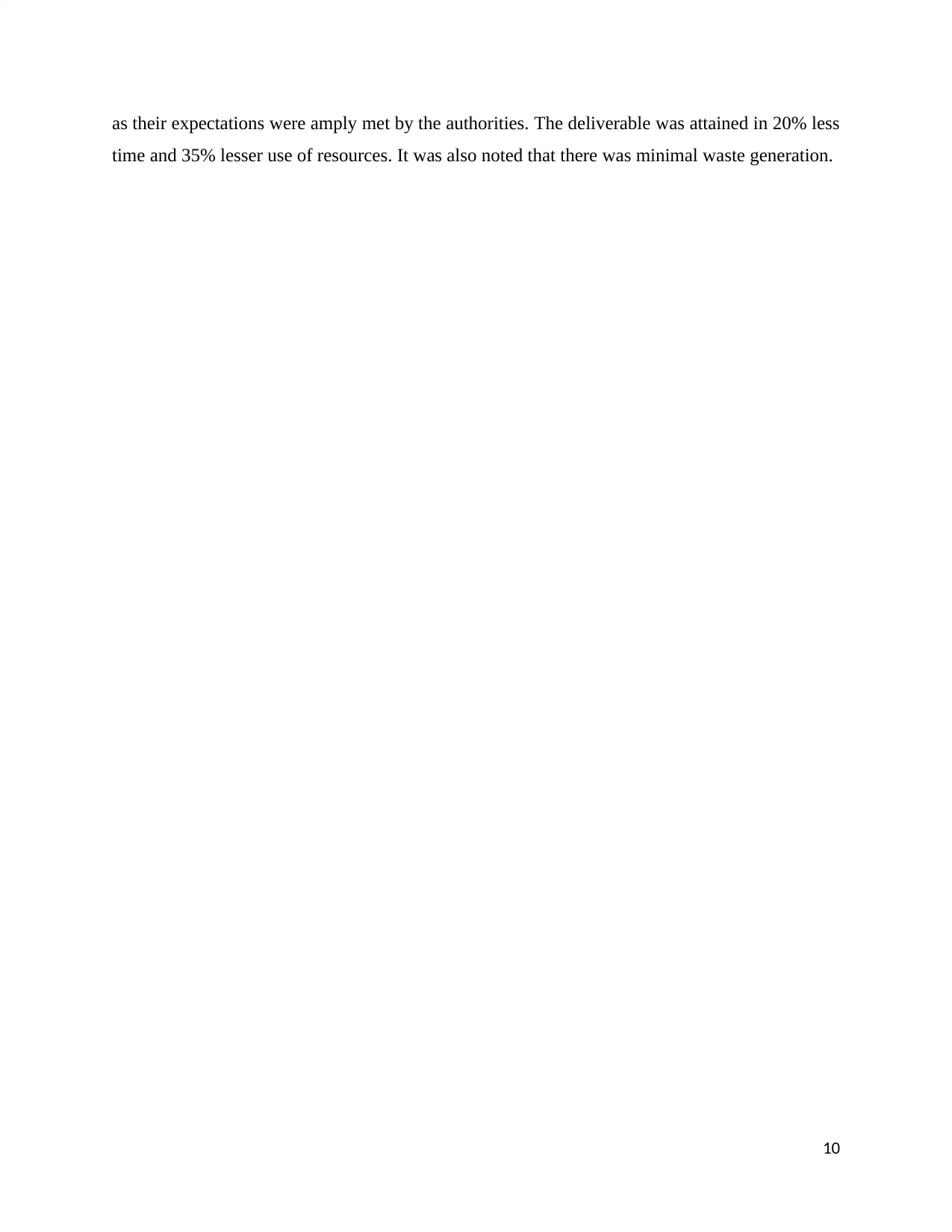
as their expectations were amply met by the authorities. The deliverable was attained in 20% less
time and 35% lesser use of resources. It was also noted that there was minimal waste generation.
10
time and 35% lesser use of resources. It was also noted that there was minimal waste generation.
10
Paraphrase This Document
Need a fresh take? Get an instant paraphrase of this document with our AI Paraphraser
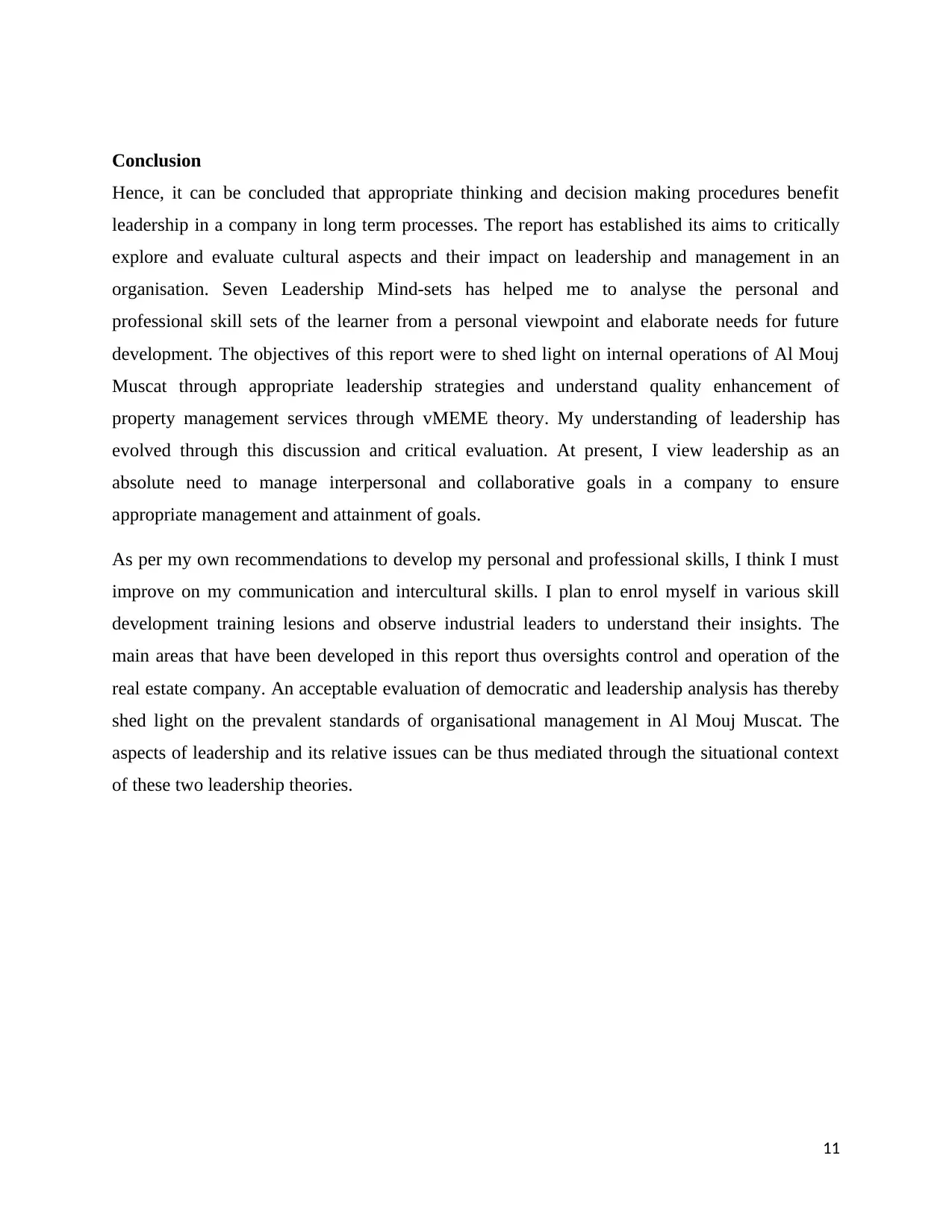
Conclusion
Hence, it can be concluded that appropriate thinking and decision making procedures benefit
leadership in a company in long term processes. The report has established its aims to critically
explore and evaluate cultural aspects and their impact on leadership and management in an
organisation. Seven Leadership Mind-sets has helped me to analyse the personal and
professional skill sets of the learner from a personal viewpoint and elaborate needs for future
development. The objectives of this report were to shed light on internal operations of Al Mouj
Muscat through appropriate leadership strategies and understand quality enhancement of
property management services through vMEME theory. My understanding of leadership has
evolved through this discussion and critical evaluation. At present, I view leadership as an
absolute need to manage interpersonal and collaborative goals in a company to ensure
appropriate management and attainment of goals.
As per my own recommendations to develop my personal and professional skills, I think I must
improve on my communication and intercultural skills. I plan to enrol myself in various skill
development training lesions and observe industrial leaders to understand their insights. The
main areas that have been developed in this report thus oversights control and operation of the
real estate company. An acceptable evaluation of democratic and leadership analysis has thereby
shed light on the prevalent standards of organisational management in Al Mouj Muscat. The
aspects of leadership and its relative issues can be thus mediated through the situational context
of these two leadership theories.
11
Hence, it can be concluded that appropriate thinking and decision making procedures benefit
leadership in a company in long term processes. The report has established its aims to critically
explore and evaluate cultural aspects and their impact on leadership and management in an
organisation. Seven Leadership Mind-sets has helped me to analyse the personal and
professional skill sets of the learner from a personal viewpoint and elaborate needs for future
development. The objectives of this report were to shed light on internal operations of Al Mouj
Muscat through appropriate leadership strategies and understand quality enhancement of
property management services through vMEME theory. My understanding of leadership has
evolved through this discussion and critical evaluation. At present, I view leadership as an
absolute need to manage interpersonal and collaborative goals in a company to ensure
appropriate management and attainment of goals.
As per my own recommendations to develop my personal and professional skills, I think I must
improve on my communication and intercultural skills. I plan to enrol myself in various skill
development training lesions and observe industrial leaders to understand their insights. The
main areas that have been developed in this report thus oversights control and operation of the
real estate company. An acceptable evaluation of democratic and leadership analysis has thereby
shed light on the prevalent standards of organisational management in Al Mouj Muscat. The
aspects of leadership and its relative issues can be thus mediated through the situational context
of these two leadership theories.
11
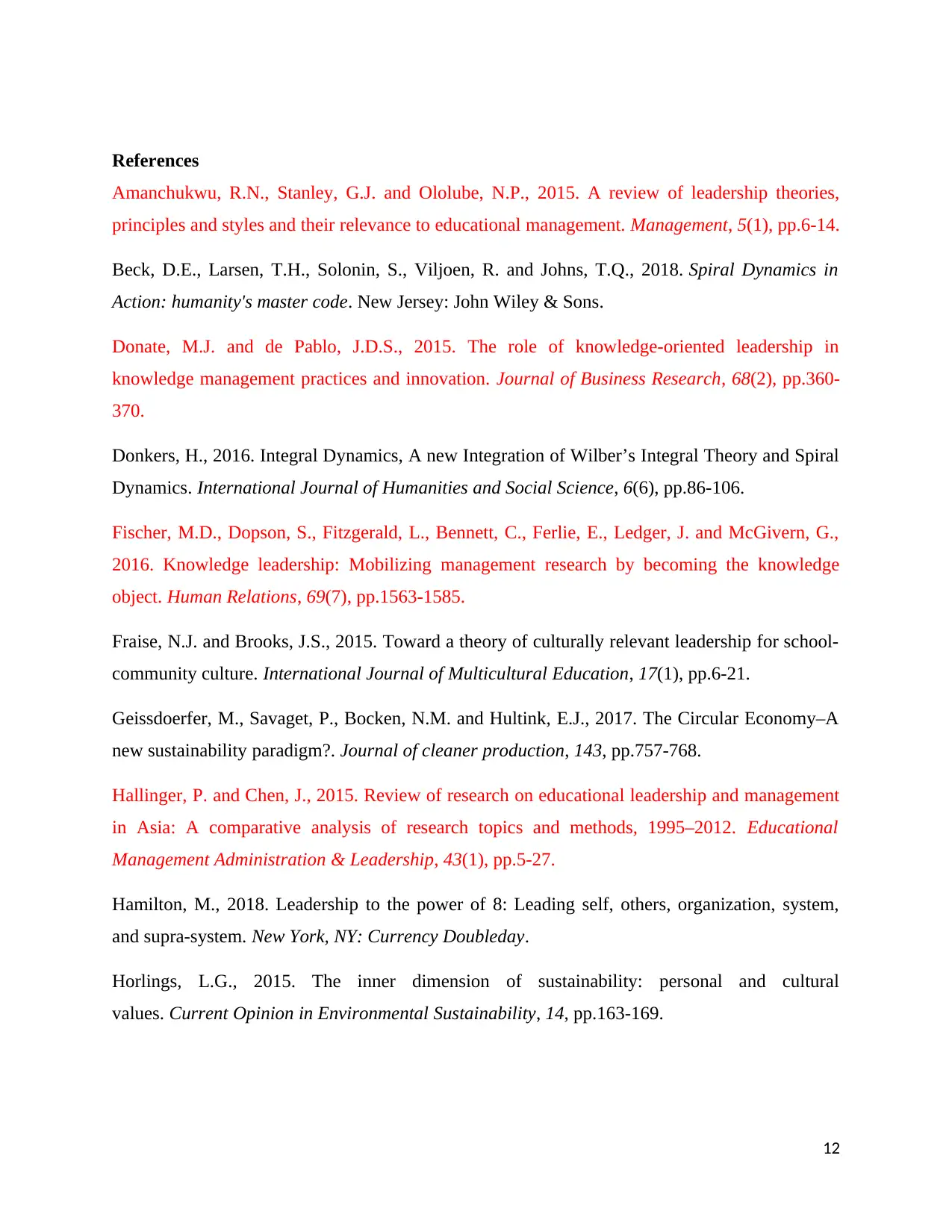
References
Amanchukwu, R.N., Stanley, G.J. and Ololube, N.P., 2015. A review of leadership theories,
principles and styles and their relevance to educational management. Management, 5(1), pp.6-14.
Beck, D.E., Larsen, T.H., Solonin, S., Viljoen, R. and Johns, T.Q., 2018. Spiral Dynamics in
Action: humanity's master code. New Jersey: John Wiley & Sons.
Donate, M.J. and de Pablo, J.D.S., 2015. The role of knowledge-oriented leadership in
knowledge management practices and innovation. Journal of Business Research, 68(2), pp.360-
370.
Donkers, H., 2016. Integral Dynamics, A new Integration of Wilber’s Integral Theory and Spiral
Dynamics. International Journal of Humanities and Social Science, 6(6), pp.86-106.
Fischer, M.D., Dopson, S., Fitzgerald, L., Bennett, C., Ferlie, E., Ledger, J. and McGivern, G.,
2016. Knowledge leadership: Mobilizing management research by becoming the knowledge
object. Human Relations, 69(7), pp.1563-1585.
Fraise, N.J. and Brooks, J.S., 2015. Toward a theory of culturally relevant leadership for school-
community culture. International Journal of Multicultural Education, 17(1), pp.6-21.
Geissdoerfer, M., Savaget, P., Bocken, N.M. and Hultink, E.J., 2017. The Circular Economy–A
new sustainability paradigm?. Journal of cleaner production, 143, pp.757-768.
Hallinger, P. and Chen, J., 2015. Review of research on educational leadership and management
in Asia: A comparative analysis of research topics and methods, 1995–2012. Educational
Management Administration & Leadership, 43(1), pp.5-27.
Hamilton, M., 2018. Leadership to the power of 8: Leading self, others, organization, system,
and supra-system. New York, NY: Currency Doubleday.
Horlings, L.G., 2015. The inner dimension of sustainability: personal and cultural
values. Current Opinion in Environmental Sustainability, 14, pp.163-169.
12
Amanchukwu, R.N., Stanley, G.J. and Ololube, N.P., 2015. A review of leadership theories,
principles and styles and their relevance to educational management. Management, 5(1), pp.6-14.
Beck, D.E., Larsen, T.H., Solonin, S., Viljoen, R. and Johns, T.Q., 2018. Spiral Dynamics in
Action: humanity's master code. New Jersey: John Wiley & Sons.
Donate, M.J. and de Pablo, J.D.S., 2015. The role of knowledge-oriented leadership in
knowledge management practices and innovation. Journal of Business Research, 68(2), pp.360-
370.
Donkers, H., 2016. Integral Dynamics, A new Integration of Wilber’s Integral Theory and Spiral
Dynamics. International Journal of Humanities and Social Science, 6(6), pp.86-106.
Fischer, M.D., Dopson, S., Fitzgerald, L., Bennett, C., Ferlie, E., Ledger, J. and McGivern, G.,
2016. Knowledge leadership: Mobilizing management research by becoming the knowledge
object. Human Relations, 69(7), pp.1563-1585.
Fraise, N.J. and Brooks, J.S., 2015. Toward a theory of culturally relevant leadership for school-
community culture. International Journal of Multicultural Education, 17(1), pp.6-21.
Geissdoerfer, M., Savaget, P., Bocken, N.M. and Hultink, E.J., 2017. The Circular Economy–A
new sustainability paradigm?. Journal of cleaner production, 143, pp.757-768.
Hallinger, P. and Chen, J., 2015. Review of research on educational leadership and management
in Asia: A comparative analysis of research topics and methods, 1995–2012. Educational
Management Administration & Leadership, 43(1), pp.5-27.
Hamilton, M., 2018. Leadership to the power of 8: Leading self, others, organization, system,
and supra-system. New York, NY: Currency Doubleday.
Horlings, L.G., 2015. The inner dimension of sustainability: personal and cultural
values. Current Opinion in Environmental Sustainability, 14, pp.163-169.
12
⊘ This is a preview!⊘
Do you want full access?
Subscribe today to unlock all pages.

Trusted by 1+ million students worldwide
1 out of 14
Related Documents
Your All-in-One AI-Powered Toolkit for Academic Success.
+13062052269
info@desklib.com
Available 24*7 on WhatsApp / Email
![[object Object]](/_next/static/media/star-bottom.7253800d.svg)
Unlock your academic potential
Copyright © 2020–2025 A2Z Services. All Rights Reserved. Developed and managed by ZUCOL.




